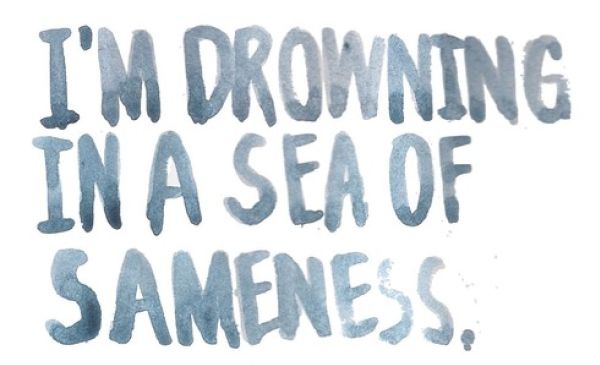
Differentiation, of course, exists, but does so on the basis of a product or service actually owning values — real or perceived, rational or emotional — and occupying a real place in the consumers’ minds — beyond the consumers just being aware of them. And the degree to which they possess these values and have meaning in the consumers’ minds (beyond primacy of product) determines whether they have differentiated themselves. But fewer and fewer products and services are able to demonstrate any degree of actual differentiation.
To prove this, Brand Keys (a New York-based loyalty and engagement research consultancy) conducted an analysis of 1,847 products and services in 75 categories via their Customer Loyalty Engagement Index. Using a combination of psychological inquiry and factor regression, and causal path analyses, the customer assessments of the products and services, predictive of how positively or negatively consumers will act toward the products, identified a continuum along which all products and services could be placed depending on their degree of differentiation. As you migrate from left to right, you go from no (or low) differentiation to extremely high differentiation.
On average, the study found that only 21% of all the products and services examined had any points of differentiation that were meaningful to the consumers. This is nearly 10% less than a benchmark study that was conducted in 2003.
On the far left are Commodities, products and services so basic that they are not differentiated in the minds of the consumer by anything other than price. Moving to the right, we have Category Placeholders. This is a new designation for products or services with strong awareness in the category in which they compete, but so absent of any meaning that they cannot be differentiated from the competition in minds of the consumer. Think General Motors or The Gap.
Next comes 21st Century Differentiated Brands. These are products and services that are strongly differentiated from the competition. Think Toyota or Apple.
Finally, the study identified the apex of differentiation, the Human Brand. This is an actual human being, most often the company founder, who represents 100% of the differentiation for the company. While this designation represents the highest level of differentiation, the fragility of brands that are invested mainly in a human being are fodder for the popular press since any sudden change in public perception of that human brand has an immediate — and potentially devastating — effect on the brand’s equity, and soon after, its profitability. Think Martha Stewart or Donald Trump.
The degree of differentiation differed by category. In the Bar Soap category, for example, 100% of the brands differentiated themselves. Fifty per cent of credit card offerings were found to stand for something in the minds of the consumers. But Banks, Motor Oil and 20 other categories — nearly one-third of all the categories examined — did not have any differentiated brands. The products and services were known, but not for anything in particular.
In general, why is this creeping commoditization happening? Because marketers are acting in ways that are diluting brands instead of building them.
First, they’re relying too heavily on promotional programs. Panicked by demands from sales departments and big retailers, manufacturers have shifted money away from brand building and into price-oriented promotions such as coupons and giveaways, that make distributors happy. The more you focus buyers on deals, the more you distract them from the brand.
Second, marketers aren’t reining in their ad agencies’ bad instincts. Instead of concentrating on how a product differs from (and outperforms) its rivals, the agencies fall prey to what we call the two curses. In the curse of the clicker, agencies are so anxious to prevent TV viewers from channel surfing during their ad that they focus on production tricks such as eye-popping graphics or strange situations to keep viewers’ thumbs off their remotes. The curse of the Clio, meanwhile, drives agencies to create clever, funny, and entertaining ads in hopes of nabbing the coveted award. What we don’t get is a distinct message that helps consumers tell one brand from another. A case in point: Another well-known research company, Copernicus, researched 340 commercials shown in prime time and identified a differentiating brand message — that is, a clear positioning — in only 7% of those ads.
Third, the sea of management consultants rarely get into this subject in a meaningful way. The reason: They don’t understand about the mind of the customer, which is where the marketing battles take place.
While it’s valid to point the finger at marketers, ultimately the CEO must take the lead in reversing any brand dilution. A loud reminder needs to come from the top that without a clear differentiating idea attached to a brand, all you’re left with to motivate buyers is price. But your competitors can cut prices too, so without strong branding, prices will fall, as will profits.
What the Brand Keys study proves is that the lack of differentiation continues to grow and this is a dangerous trend. In the real marketplace, today’s marketers must be able to accurately pinpoint their products’ and services’ points of differentiation or they will become Category Placeholders. And that’s just one step away from becoming a commodity.
What’s missing is what used to be called a USP (or unique selling proposition).
The Blake Project Can Help: The Brand Positioning Workshop
Branding Strategy Insider is a service of The Blake Project: A strategic brand consultancy specializing in Brand Research, Brand Strategy, Brand Licensing and Brand Education




